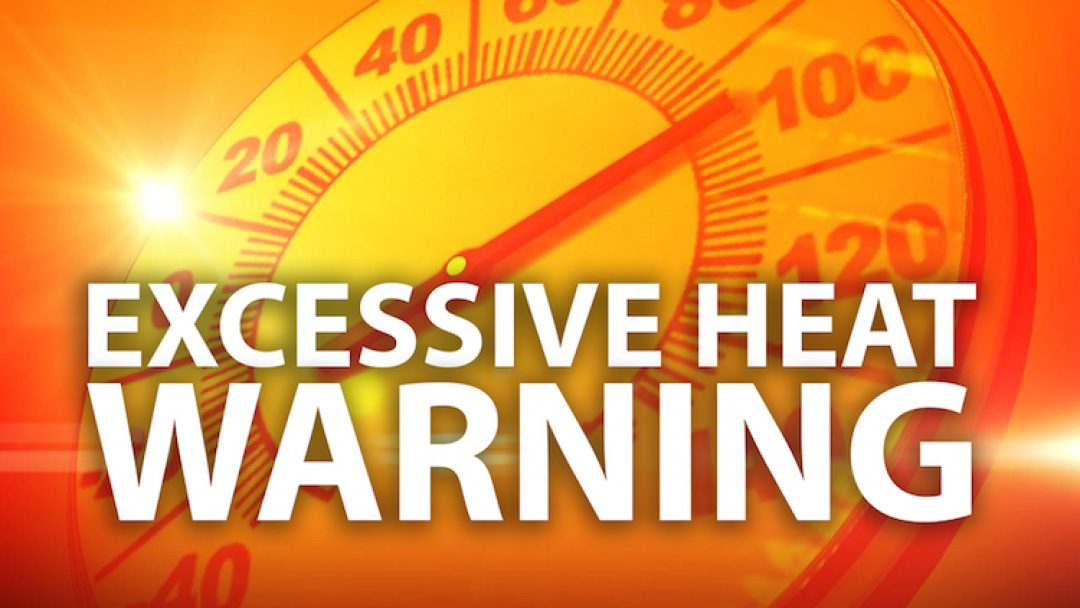The Los Angeles County Health Officer has issued an excessive heat warning as high temperatures have been forecast for the Santa Clarita Valley and the following areas:
West San Fernando Valley: EXCESSIVE HEAT WARNING effective Sept. 3 through Sept. 6.
Santa Clarita Valley: EXCESSIVE HEAT WARNING effective Sept. 4 through Sept. 6.
Los Angeles Inland Coast: EXCESSIVE HEAT WARNING effective Sept. 4 through Sept. 6.
West Santa Monica Mountains: EXCESSIVE HEAT WARNING effective Sept. 4 through Sept. 6.
East Santa Monica Mountains: EXCESSIVE HEAT WARNING effective Sept. 4 through Sept. 6.
Calabasas/Agoura Hills: EXCESSIVE HEAT WARNING effective Sept. 4 through Sept. 6.
East San Fernando Valley: EXCESSIVE HEAT WARNING effective Sept. 4 through Sept. 6.
Santa Susana Mountains: EXCESSIVE HEAT WARNING effective Sept. 4 through Sept. 6.
Northwest LA County Mountains/I-5 Corridor: EXCESSIVE HEAT WARNING effective Sept. 4 through Sept. 6.
Western San Gabriel Mountains/Hwy 14 Corridor: EXCESSIVE HEAT WARNING effective Sept. 4 through Sept. 6.
East San Gabriel Mountains: EXCESSIVE HEAT WARNING effective Sept. 4 through Sept. 6.
Western Antelope Valley: EXCESSIVE HEAT WARNING effective Sept. 4 through Sept. 6.
Antelope Valley: EXCESSIVE HEAT WARNING effective Sept. 4 through Sept. 6.
Eastern Antelope Valley: EXCESSIVE HEAT WARNING effective Sept. 4 through Sept. 6.
San Gabriel Valley: EXCESSIVE HEAT WARNING effective Sept. 4 through Sept. 6.
To check the risk of heat-related impacts for your specific city, go to the National Weather Service’s HeatRisk website and click on Location Search and enter your city or use the zoom (+) button in the top left corner to see nearby cities more clearly. For actions to take based on your city’s HeatRisk category, read the NWS’ Understand HeatRisk guide.
Public Health reminds everyone to take precautions to avoid heat-related illness, especially older adults, young children, pregnant people, outdoor workers, athletes and those with a chronic medical condition who are more at risk for negative health impacts from extreme heat. Public Health recommends the following actions be taken on days with high temperatures:
Stay Hydrated: Drink plenty of water to keep hydrated throughout the day. Your body loses water more rapidly through sweating to cool itself down. Drinking enough water helps you replenish the lost water and maintain proper bodily functions, prevent dehydration and reduce the risk of heat-related illnesses.
Think ahead, Plan, and Protect: If you need to go outside, avoid going out during the hottest hours. Wear sunscreen, lightweight and light-colored clothes and wear a hat or use an umbrella.
Car Safety: Cars get very hot inside, even with the windows ‘cracked’ or open. Never leave children or pets in cars. Call 911 if you see a child or pet in a car alone in a car.
Recognize Heat Illness: Be aware of the symptoms of heat-related illness like heat exhaustion and heat stroke and know what to do to care for them. Call 911 right away if you see these symptoms: high body temperature (103°F or higher), vomiting, dizziness, confusion and hot, red, dry or damp skin. Heat stroke is a medical emergency.
Check on People More At-Risk: Regularly check on those at risk for heat-related illness, like those who are sick or have chronic conditions, older adults, pregnant people, children, those who live alone, pets and outdoor workers and athletes.
Prepare for Power Outages: Visit your power company’s website or contact them by phone to determine if you are scheduled for a rolling power outage.
“Although it’s crucial that we take care of ourselves, it’s equally important that we extend our hand to those in need. We must look out for those who are more likely to get ill due to the heat, including the elderly, unwell, pregnant women, children, and those living alone. Hot days aren’t just uncomfortable — they can be dangerous,” said Muntu Davis, MD, MPH, Los Angeles County Health Officer. “However, if we make sure to stay hydrated and keep cool, we can protect ourselves and our loved ones, friends, and neighbors. If you have an elderly or unwell family member or neighbor, check on them regularly to ensure they are safe and well.”
County and city partners have planned ways to safely operate cooling centers during times of high heat. Residents who do not have access to air conditioning are encouraged to take advantage of these free cooling centers, splash pads, and community pools. To find a location near you, visit https://ready.lacounty.gov/heat/ or call 211.
The NWS HeatRisk takes into consideration:
How unusual the heat is for the time of the year
The duration of the heat including both daytime and nighttime temperatures
If those temperatures pose an elevated risk of heat-related impacts based on data from the Center for Disease Control (CDC)
Los Angeles County residents and business owners, including people with disabilities and others with access and functional needs can call 2-1-1 for emergency preparedness information and other referral services. The toll-free 2-1-1 number is available 24 hours a day, seven days a week. 211 LA County services can also be accessed by visiting 211la.org.
Like this:
Like Loading...
Related





 Tweet This
Tweet This Facebook
Facebook Digg This
Digg This Bookmark
Bookmark Stumble
Stumble RSS
RSS




























REAL NAMES ONLY: All posters must use their real individual or business name. This applies equally to Twitter account holders who use a nickname.
0 Comments
You can be the first one to leave a comment.